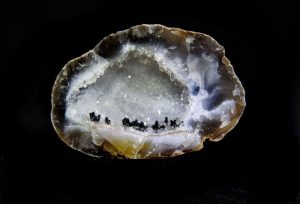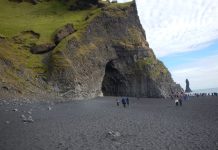
Oco geodes (AKA Ocho geodes) are found in a remote area known as Tres Pinheiros (Three Pines) near the southern border of Brazil at an elevation of 3,000 feet. This area’s geological history, characterized by volcanic activity and lava flows, provides the perfect conditions for the formation of these tiny geodes.

Finding Geodes
Most Ocos are found in the dark red-brown soil produced from the weathering of the basalt rock in which they formed. Other Ocos are chiseled directly out of the basalt rock.
In the off-season, farmers plow their fields to find these tiny geodes. The geodes are collected and transported down the mountains in burlap sacks and buckets where they are sold “as is” to be cut or cut and polished to be sold.
There are multiple theories about where Oco geodes got their name. One is that they are named after the Orinoco River, the other is that their name comes from the Portuguese word for “hollow.”
Oco Geodes – Internal Structure

Richard Gross
Even though most Ocos are small (one to three inches) they are attractive to collectors, along with Las Choyas geodes and trancas geodes, for the secondary mineral formations they contain. The crystals found within these geodes vary in composition but often include minerals such as quartz and amethyst.
Oco geodes have two distinguishing characteristics that make identification easy. The outer chalcedony shell is rope-like and when the internal chalcedony layer is exposed, it shows swirling “flame-like” patterns. They also have a very thin shell. Care must be taken when they are cut and polished.
Tranquil Oco Geodes
Believers in the power of crystals associate Oco geodes with harmony, balance, and a sense of tranquility.
This story about Oco geodes previously appeared in Rock & Gem magazine. Click here to subscribe. Story by Richard Gross and Pam Freeman.












